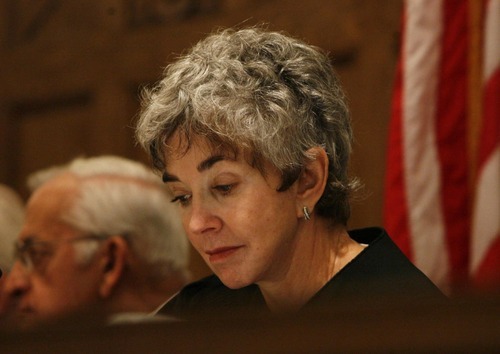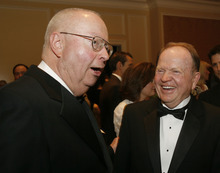This is an archived article that was published on sltrib.com in 2011, and information in the article may be outdated. It is provided only for personal research purposes and may not be reprinted.
David Calder waited for justice for nearly five years after his 2-year-old daughter died during a 2005 camping trip when a gas can exploded inside his trailer.
In 2007, the Magna man filed a civil lawsuit in U.S. District Court against Oklahoma-based Blitz USA, claiming the company failed to equip the gas can with a cheap safety device known as a flame arrester.
The device is intended to prevent flames from creeping into the container and causing it to explode.
Calder's case inched forward in court. But his medical expenses reached more than $200,000 after spending two months in a hospital's burn unit and undergoing skin-graft surgeries for burns covering 36 percent of his body.
While at times frustrated with the pace of his lawsuit as bills piled up, Calder and his attorney, Donald J. Winder, watched as Judge Tena Campbell tried to expedite the case by scheduling potential hearings for Saturdays and limiting breaks at trial. After 4½ years of legal maneuvering, a jury in November awarded Calder $4.32 million.
Watching federal judges juggle growing caseloads has become commonplace for Winder and other attorneys who practice law in Salt Lake City's federal courthouse. But it's also become concerning.
Civil and criminal case filings have jumped 25 and 23 percent, respectively, according to a court analysis of cases filed between July and January during the past two years. The increase comes at a time when President Barack Obama has yet to fill two federal District Court judge vacancies out of five full-time positions.
One of the spots has sat vacant since November 2009, when Judge Dale Kimball assumed senior status — a form of semi-retirement awarded to long-serving judges. Campbell achieved senior status in January, meaning she'll also take on fewer cases.
That amounts to a 40 percent reduction in the number of active judgeships, with Obama's administration giving little indication about when relief might come, said Utah State Bar President Robert Jeffs.
—
No relief in sight • Utah's shortage is among 101 vacancies nationwide in the country's 857 district and circuit judgeships, according to the Administrative Office of the U.S. Courts. More vacancies are expected as judges continue to retire.
The reduction of judgeships in Utah is problematic for several reasons, Jeffs said.
Judges such as Kimball and Campbell, who've earned the right to reduced caseloads, are taking on more work just to keep the system afloat, Jeffs said. In November, Kimball, for example, presided over the six-week trial of Brian David Mitchell, who was convicted of the 2002 kidnapping and rape of Elizabeth Smart. All four senior judges on the federal bench continue to take prominent cases.
The shortage of district judges has also led magistrate judges, who typically hear misdemeanors and prepare other cases for trial, to pick up additional cases. The court suffered another blow when Judge J. Thomas Greene, who served part time as a federal judge with senior status, died earlier this month.
Chief Judge Ted Stewart, Judge Dee Benson and Judge Clark Waddoups are left to balance a current average of 341 civil cases and 128 criminal cases.
"You have three people trying to do the work of five," said Jonathan Pappasideris, president-elect of the Utah Chapter of the Federal Bar Association. "With case filings increasing, that creates a bottleneck where justice gets delayed."
—
Civil cases suffer • Civil cases such as Calder's are second fiddle to criminal cases, which have federally imposed time limits.
During the past five years, the median time it takes for civil cases to move from filing to trial has increased from 24.5 months to 33.3 months, according to statistics kept by the Administrative Office of the U.S. Courts.
In 2010, out of the 1,503 civil cases filed, nearly half languished on a court docket for more than 271 days, Jeffs said.
Twenty-five percent of civil cases filed in 2010 stayed on the court docket for more than 541 days.
Jeffs said the perception of federal court from attorneys who practice there — and in state courts — has changed.
"We used to always consider federal court as accelerated justice. You could get to trial in less than a year," he said.
Jeffs, who specializes in business litigation, said that means his businesses are hampered from carrying out daily operations while waiting for courts to enforce their rights. More broadly, he said, disputes languishing in court could motivate parties to take the situation into their own hands.
"We're fearful that it could result in an erosion of the public's confidence in the judicial system," Jeffs said.
Attorneys and the federal judges have few answers from Congress as to when the pattern will change.
Sen. Orrin Hatch, R-Utah, who sits on the Senate Judiciary Committee, and as freshman Sen. Mike Lee said they're frustrated by the holdup, but their hands are somewhat tied until Obama moves forward with his nominations.
Hatch said he has sent Obama the names of "highly qualified candidates" for both vacant positions, but he can't disclose the names until the process is complete. The Senate has received nominations for fewer than half the current vacancies —only 47 nominees for 101 positions, Hatch said.
"President Obama has not chosen to put the same priority on filling these positions as I believe he should," Hatch said. "I am waiting for the president to finish the process and nominate qualified individuals for the court, so that the Senate can finish the confirmation process.
"The Senate is handling President Obama's nominees as he makes them. However, he needs to make the nominations. Until he does, the vacancies in Utah, and across the country, will remain unfilled."
—
Solving the problem • Jeffs, Pappasideris and others from Utah's state and federal bars are stepping up their lobbying efforts. They've drafted a letter to White House counsel and also plan to request that Utah join 22 other states dubbed "judicial emergencies," with judges carrying caseloads far higher than the number deemed manageable by the Judicial Conference of the United States.
Carl Tobias, a University of Richmond law professor who has taken an interest in the Obama administration's lagging judicial appointments, said the judicial vacancy rate has hovered at 11 percent during Obama's tenure — much higher than the 4 percent vacancy rate during the Bush administration but about the same as the 10 percent vacancy rate under former President Bill Clinton. Judgeship vacancies have nearly doubled since Obama took office in 2009, when only 54 seats were open, he said.
Tobias said the painstaking process that judicial nominees go through could deter some candidates from coming forward.
"Some people might say, 'I don't want to wait a year in limbo. My clients will leave me' and all of that. They see people wait forever after they're nominated. If it's going to be such a pressure-cooker job, who wants it?" Tobias asked. "A lot of attorneys in private practice can make more money than they would as a federal judge."
He cited the December Senate confirmation of federal Judge William Martinez, which came after two years of wrangling to seal the appointment. Republicans criticized Martinez's work on a legal panel for the American Civil Liberties Union after his nomination by Obama. Martinez eventually gained approval from the Senate Judiciary Committee, but not until months after Obama first suggested him.
Representatives from the Utah State Bar and state chapter of the Federal Bar Association hope a similar situation doesn't happen in Utah.
White House spokesman Adam Abrams said the president wants to work with Utah's delegation to move quality nominations for Utah's judicial vacancies forward.
Earlier this month, the Senate approved Obama nominees for open judgeships in three states, while eight more nominees for other posts remain on the table and could soon receive Senate approval.
"The White House will continue to consult with the Utah delegation in the selection process, and the president looks forward to nominating judges who respect the rule of law and understand how the law impacts Americans' daily lives. When brought to a floor vote, the president's nominees have been confirmed with strong bipartisan support," Abrams said.
Meanwhile, attorneys representing clients such as Calder will have to be patient. Winder complimented Campbell and Utah's other federal judges for often going above and beyond their normal duties to move cases along.
"I think our judges do a wonderful job, given the shortage," Winder said.
The Associated Presscontributed to this report. —
Federal case filingson the rise
Civil, up 25 percent
905 • July 2010-January 2011
724 • July 2009-January 2010
Criminal, up 24 percent
986 • July 2010-January 2011
796 • July 2009-January 2010
Source: • Utah's U.S. District Court —
How federal judges are selected
The president appoints district judges, who must be approved by the U.S. Senate's Judiciary Committee and then the full Senate. The court of appeals in each circuit appoints bankruptcy judges for 14-year terms. District courts appoint magistrate judges for eight-year terms.
Source • Federal Judicial Center —
Larger caseloads
Each of Utah's three active federal district judges currently handle 341 civil and 128 criminal cases on average each year.
Four senior judges are each handling 137 civil and 47 criminal cases.
Five magistrates are each handling 26 civil cases and 44 criminal matters in addition to preparing cases to go before a district judge.
Source • Federal Judicial Center, Utah's U.S. District Court, Utah State Bar, Utah Chapter of the Federal Bar Association —
Judge vacancies remain as Utah awaits new federal courthouse
The U.S. General Services Administration will break ground Thursday on a new, $186 million, 409,397-square-foot federal courthouse at 351 S. West Temple in Salt Lake City.
A program featuring Gov. Gary Herbert, members of Utah's congressional delegation, and U.S. District Court Judge Tena Campbell begins at 1:30 p.m. Because of security concerns, the ceremony is not open to the public but will be covered by the news media.
The courthouse, scheduled for completion in spring 2014, will include nine courtrooms, 14 judges' chambers and office support spaces. Parking will be included below the building.





